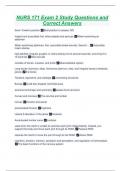NURS 171 Exam 2 Study Questions and
Correct Answers
Semi- Fowler's position ✅Best position to assess JVD
Inspect and auscultate first, when palpate and percuss ✅When examining an
abdomen
When examining abdomen, first, auscultate bowel sounds. Second ... ✅Auscultate
major arteries
high-pitched, irregular gurgles, or clicks lasting one to several seconds, occurring 5 to
15 seconds ✅Bowl sounds
consists of bones, muscles, and joints ✅Muscuskeletal system
Long bones (humerus, tibia), flat bones (sternum, ribs), and irregular bones (vertebrae,
pelvis) ✅the bones
Tendons, ligaments, and cartilege ✅connecting structures
Bursae ✅small disc-shaped, fluid filled sacs
examine bod shape and symmetry ✅assess bone structure
Curves and concave ✅The cervical and lumbar
convex ✅thoracic and sacral
accentuated thoracic ✅Kyphosis
Lateral S deviation of the spine ✅Scoliosis
Accentuated lumbar curve ✅Lordosis
used when the client is unable to exercise each joint independently. Instead, you
support the body and move each joint through its ROM. ✅Passive ROM
requires the client to move the joint through its full ROM. ✅Active ROM
cognition, emotion, memory, sensation and perception, and regulation of homeostasis.
✅The basic functions of the nervous system
, refers to the client's intellectual and behavioral functioning ✅Cerebral function
Arousal ✅classified based on the type of stimuli (auditory, tactile, or painful) required
to produce a response from the client.
Orientation ✅refers to the client's awareness of time, place, and person.
behavior, appearance, response to stimuli, speech, memory, communication, and
judgment ✅Mental status and cognitive functionseye opening, motor responses, and
verbal responsive
eye opening, motor responses, and verbal responses ✅The GCS (Glasgow Coma
Scale) evaluates
additional information beyond that of the GCS for assessing brain ✅Full Outline of
UnResponsiveness (FOUR
Alert ✅Follows commands in a timely fashion.
Lethargic ✅Appears drowsy; easily drifts off to sleep.
Stuporous ✅Requires vigorous stimulation before responding.
Comatose ✅Does not respond to verbal or painful stimuli.
automatic responses that do not require conscious thought from the brain ✅Deep
Tendon Reflexes (DTRs)
0 to 4+ scale ✅Each DTR corresponds to a certain level of the cord and is graded on a
superficial reflexes ✅You can elicit _____________________ by swiftly and lightly
stroking a body part
Olfactory cranial nerve ✅Sensory nerve, smell
Optic cranial nerve ✅Sensory nerve, visual acuity, visual fields, and ocular fundi
Oculomotor cranial nerve ✅Motor nerve, EOM, pupil constriction
Trochlearcranial nerve ✅Motor nerve, EOM




